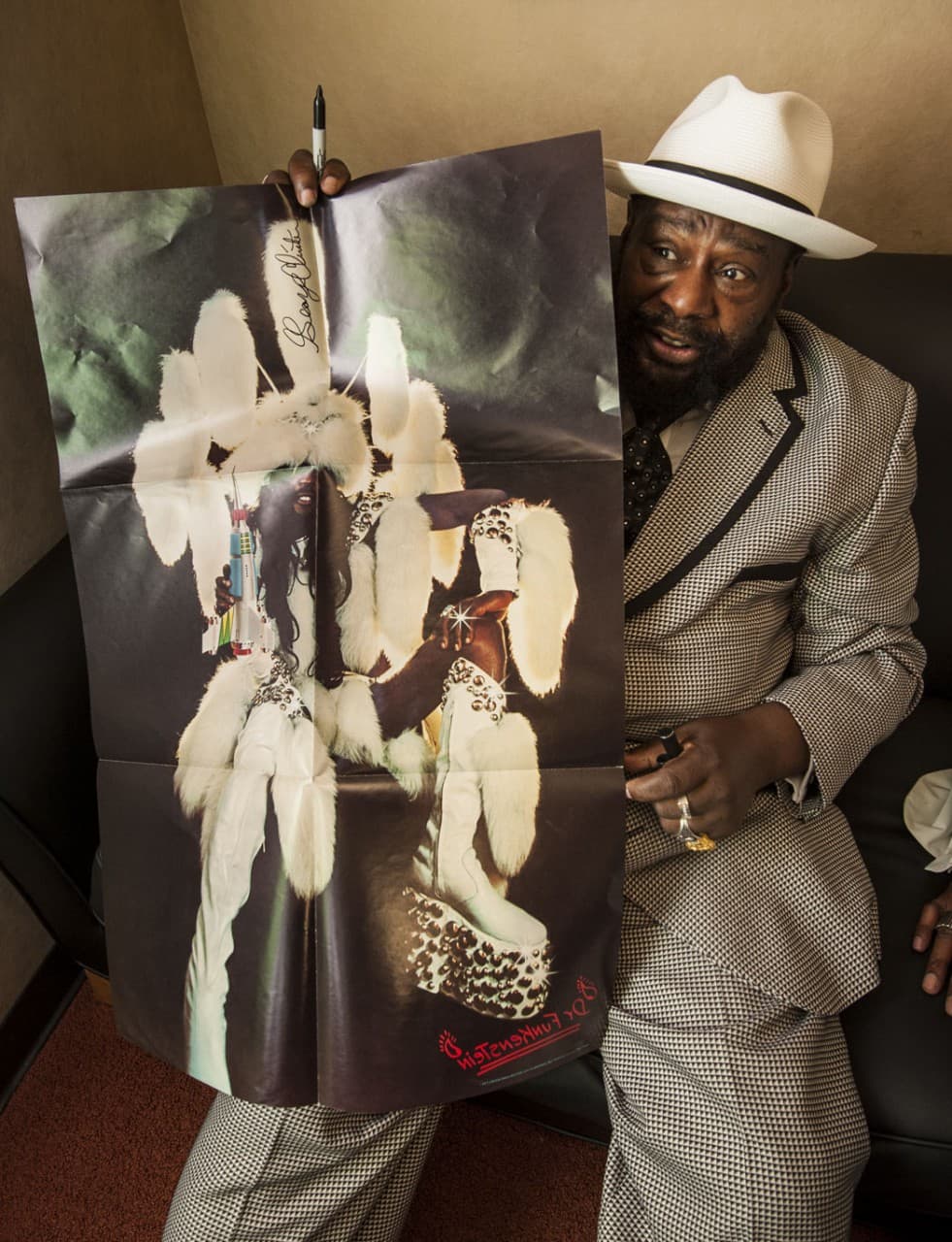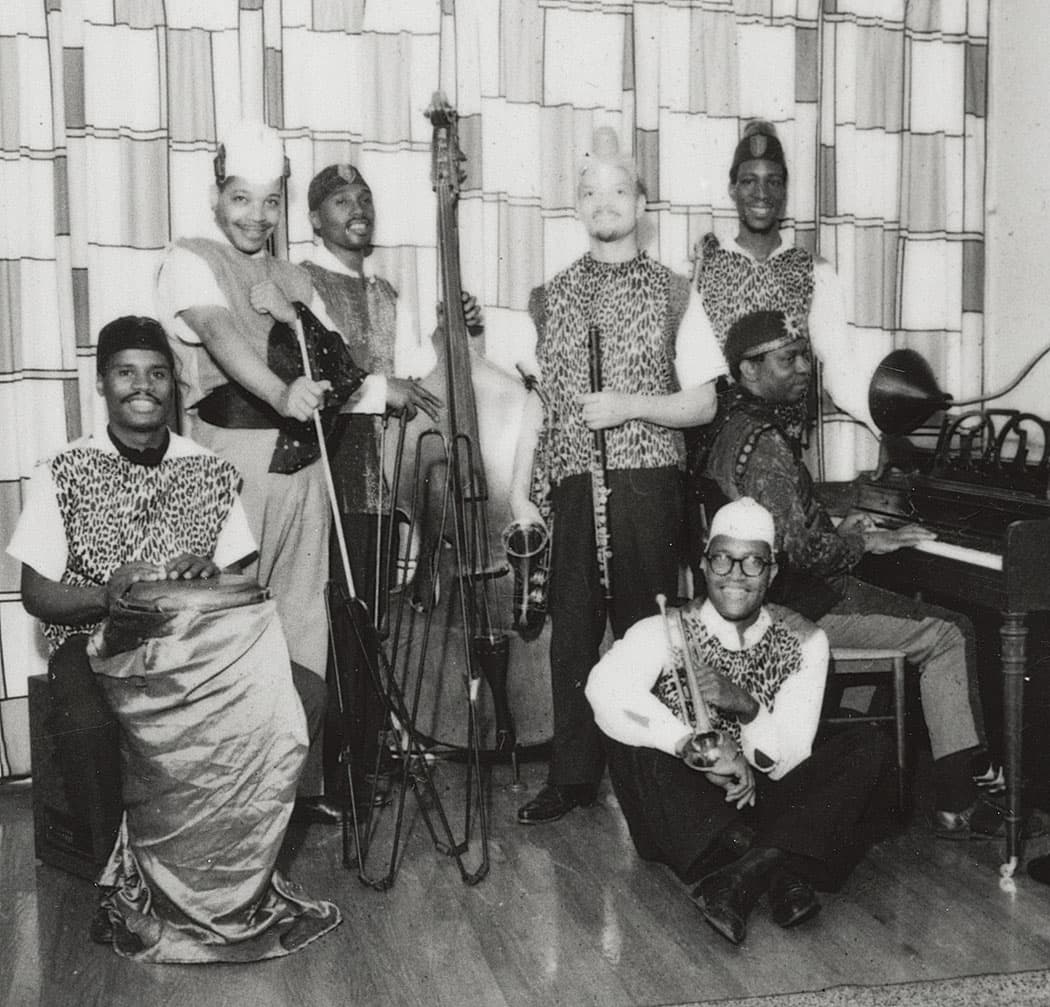Advertisement
George Clinton, Sun Ra And The Sci-Fi Funk Of Afrofuturism
Funk is not just a type of music. It’s a state of being, and a technicolor, utopian universe unto itself. It’s “home of the extraterrestrial brothers,” as the sonorous, liquid-tongued voice of a radio DJ explains in introduction to the seminal 1975 funk album “Mothership Connection” by Parliament.
“Do not attempt to adjust your radio, there is nothing wrong,” the DJ croons. “We have taken control as to bring you this special show. We will return it to you as soon as you are grooving.”
The now-captive listener is exhorted to free herself from her earthly existence with the help of something called “P-Funk.” What follows is a 40-minute, downbeat-driven trip (possibly drug-induced) through a cosmic soundscape overrun with saxophones, falsetto-sung hooks, and puns involving the word “funk.”
The music is soothing in its repetitiveness, but not without an edge. “I want my funk uncut,” sings the background chorus on the first track. It’s a psychedelic concoction of good vibes rooted in a raw, relentless groove.

What is P-Funk? “Pure funk,” says Parliament’s George Clinton, speaking over the phone from his home in Tallahassee, Florida. He plays the House of Blues in Boston with Parliament Funkadelic on March 7. “This is as funk as you’re gonna get it.” And what is funk? “Funk is anything you need to be when it needs to be that.”
“Mothership Connection,” like so many recordings of Clinton’s bands Parliament and Funkadelic (the two groups were eventually merged under one name, Parliament Funkadelic), envisions a space-age setting in which black characters are the primary protagonists and cultural arbiters of the future. Parliament’s stadium shows during the 1970s were known to be visited by an enormous, sparkly UFO that emerged from the ceiling amidst billowing smoke and pyrotechnics. (This original “Mothership” prop was eventually discarded, but a replica created for 1990s performances was acquired by the Smithsonian’s National Museum of African American History and Culture last year.)
Cultural critic Mark Dery coined the term “Afrofuturism” in 1993 to describe the particular strain of science fiction concerned with black experiences. P-Funk’s universe was inspired by Clinton’s love of television shows like “Star Trek” and films like “Close Encounters of the Third Kind.”
Sci-fi authors have long used the genre to grapple with social problems, propose better futures, or to imagine society’s disastrous potential in dystopian worlds. Afrofuturism uses the genre to riff on experiences of the African Diaspora. Black artists address contemporary racism by imagining funkier, more colorful (in every sense), sci-fi futures. P-Funk is populated by transcendent "Afronauts, capable of funkitizing galaxies," as Clinton has said. But the genre also features clashes with aliens, which serve as allegories for racism. Afrofuturism seems especially visible right now—and relevant as we muddle through the not-so-utopian realities of our so-called “post-racial” era.

Its origins are found in the work of jazz phenomenon Sun Ra, a musician so thoroughly committed to his otherworldly vision that he maintained that he was from the planet Saturn throughout much of his professional life, and dressed his band in glittery Egyptian pharaoh crowns and pan-African hats and togas. His legacy is the focus of a talk, “Sun Ra’s Centenary: Space Is Still the Most Colorful Place,” at Boston’s Museum of Fine Arts on May 11. Berklee College of Music marked the centenary with a Feb. 20 concert by members of Sun Ra’s Arkestra, led by longtime member Marshall Allen since Sun Ra’s death in 1993. (Governor Deval Patrick was in attendance as his late father, Laurdine “Pat” Patrick, played baritone saxophone with the band.)
For Clinton, whose most influential work preceded the critical label under which it is now shelved, science fiction was a natural fit mainly because it was so popular in the media of his youth. “Buck Rogers was the beginning of television,” says the 72-year-old, referring to a 1950 TV series that took place in the year 2430.
Historical visions of the future, which often predict incredible feats of space and time travel using special effects that are laughably crude in comparison, can seem quaint to contemporary audiences. Clinton’s albums, with their psychedelic leanings and ‘70s slang, are clearly products of their time. But his work has continuously re-emerged as a landmark for black musicians, even as his career has waxed and waned. He experienced a spike in popularity in the ‘90s when rappers like Dr. Dre and Ice Cube started sampling his records. Today, his influence is especially felt in the work of R&B singer Janelle Monáe, a self-styled “android” whose albums take place in a post-apocalyptic future populated by robots.

Monáe is not the only contemporary artist to link overtly with the Afrofuturist leanings of Clinton and Sun Ra. An exhibit at the Studio Museum in Harlem titled “The Shadows Took Shape,” which takes its name from a Sun Ra poem and runs until March 9, expressly explores Afrofuturist ideas through visual art and multimedia.
“Working with contemporary visual culture these last few years, I kept coming across work in a number of different contexts and media that I felt spoke directly to Afrofuturist concerns. They often owed a debt—whether conscious or unconscious—to the Afrofuturist strategies that have come before,” said the exhibit’s co-curator Zoe Whitley in an email.
The museum’s assistant curator, Naima J. Keith, singles out a short film from the exhibit: “In Wanuri Kahiu’s film ‘Pumzi,' the director depicts the story of a community forced into subterranean sequester by a ‘water war.’ Asha, the central (human) character ... is a museum archivist/curator who risks the security of her world in order to nurture a plant that manages to flourish in the post-apocalyptic landscape.”
Monáe’s most recent album, “The Electric Lady,” hinges on similar dystopian themes, with a plot revolving around a “droid rebel alliance” and an underground android community pitted against “clones and humans”—although the DJ playing host to this particular futuristic concept album preaches “love, not war.” Androids—robots built to serve humans—are an apt allegory for slaves, or at the very least, a long-oppressed Other. Monáe’s mythology, which she introduced in 2007’s “Metropolis,” contains a feminist twist on classic Afrofuturism, with a messianic android heroine named Cindi Mayweather, aka The Electric Lady.
The post-apocalyptic milieu of today’s Afrofuturism is somewhat in contrast to that of its forbears. The Sun Ra mythology is primarily concerned with transcendence, rather than the conflict—race-based oppression—that requires transcending. Sun Ra’s lyrics and poetry ruminate on spirituality and seek a deeper connection with the cosmos. His music, which integrates big band sensibilities with free jazz, is a glorious mix of meditative grooves and cacophonous dissonance, a kind of sonic melting pot.
Likewise, Clinton espouses a universalist philosophy. “Look at blues, there were more white people in the blues in the ‘60s than there was black people,” he points out. “That’s just the way the evolution of music goes.” He acknowledges cultural appropriation with a generous shrug. “It’s the 21st century,” he says. “We got lots of other things to deal with, so we might as well dance together on the one.” “The one” refers to the first beat in a measure, a neat musical shorthand for togetherness.
That’s not to say that contemporary Afrofuturism has left behind the quest for spiritual and social apotheosis that characterized its earlier iterations—after all, its exploration of a fantastical future is an inherently transcendence-oriented project. And it’s not as though Clinton’s funk was entirely free of conflict, either. Though the DJ narrator in “Mothership Connection” is friendly, there is an undercurrent of revolution to his polite announcement at the beginning of the album: “We have taken control.” There is power in the airwaves, Clinton seems to say. Those that have been denied a voice must unleash it, before any dancing can be done.
Amelia Mason is a writer, musician, and bartender living in Somerville. She is a regular contributor to The ARTery. You can follow her on Twitter @shmabelia and Tumblr.
Correction: An earlier version of this article incorrectly reported the date of George Clinton's concert at the House of Blues.
This article was originally published on March 02, 2014.


